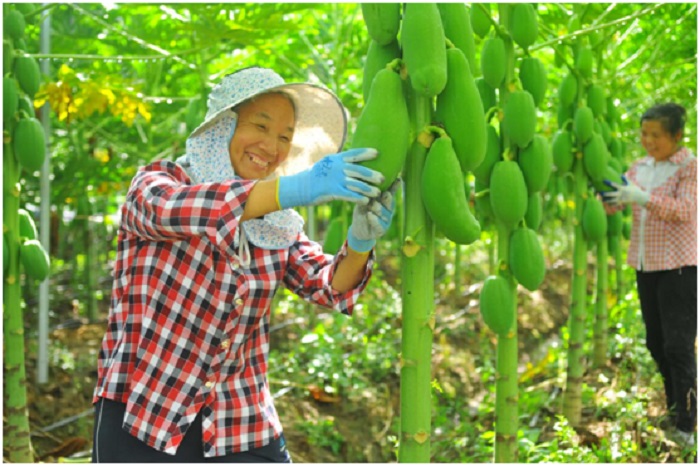



Since 2012, departments of agriculture and rural affairs of local governments in various areas of China have continuously boosted industries in poverty-stricken regions.
Over the years, the country’s 832 national-level once-impoverished counties have established over 300,000 industrial bases of various kinds, and 98 percent of the once poor residents in China have benefited from policies on eliminating poverty through developing industries. Meanwhile, poverty-stricken regions in China have seen significant improvement in the environment for the development of industries.
Industrial development is considered the most direct and effective route to poverty reduction as well as a long-term solution to pumping new blood into poor areas and helping impoverished villagers secure jobs in their hometowns.
Reducing poverty via industrial development has become the most widely adopted, the most effective, and most sustainable approach in China’s fight against poverty, said Liu Huanxin, China’s vice minister of agriculture and rural affairs.
The approach helped increase the per capita net income of poor residents to 9,808 yuan (about $1,520) in 2019 from 3,416 yuan in 2015, logging an average annual increase of 30.2 percent, according to Liu.
“Thanks to the black cardamom industry, we have become better-off,” said Ma Wenjun, a villager in Bapo village, Nujiang Lisu autonomous prefecture, southwest China’s Yunnan province. Last year, Ma achieved a bumper harvest of his over 60 mu (about 4 hectares) of black cardamoms and gained an income of over 100,000 yuan.
According to Ma, local people are enthusiastic about the industry, which is now the village’s pillar industry.
In 2020, Nujiang Lisu autonomous prefecture became a core production area of black cardamoms in China. The prefecture planted 1.11 million mu of black cardamoms, benefiting 165,000 poor villagers.
Tianlin county, south China’s Guangxi Zhuang autonomous region, has continuously upgraded its bamboo shoot industry for poverty alleviation by measures including improving low-yield bamboo groves, introducing preliminary processing factories, and setting up core demonstration zones for bamboo shoot industry.
The county’s annual output value of dried bamboo shoots has exceeded 200 million yuan.
Taking advantage of local bamboo grove resources, Tianlin county has built a sightseeing passage to bamboo groves, developed a series of products such as bamboo shoot canned food and pickles, and continuously increased the value of low-yield bamboo groves.
“I have grown bamboo shoots for over 20 years, yet it was until recent years that I have been able to double my income,” said Wu Zaimeng, a resident in Pingxi village of Tianlin county, who attributed her income growth to the county’s efforts to upgrade bamboo shoot industry.
Last year, Wu sold all the fresh bamboo shoots of her family to a local processing plant and earned over 70,000 yuan.
The 832 once-impoverished counties in China have built 43,000 preliminary processing facilities for agricultural products, which have helped increase the preliminary processing capacity of the industries in these counties by nearly 8.3 million tons and create more jobs and revenues from added value of industries.
Various areas in China have also established long-term mechanisms to increase residents’ incomes and alleviate poverty through developing industries. They have cultivated and introduced 67,600 enterprises of various types, set up 719,000 farmers’ cooperatives, and developed more than 150,000 family farms.
Besides, they have basically ensured that local leading enterprises play a leading part in facilitating pillar industries.
With the help of agricultural technicians, Pu Shouguo, a once-impoverished resident in Jinguang village, Wangcang county, southwest China’s Sichuan province, has changed from a green hand to an expert in growing yellow tea.
“By adopting scientific methods, we can guarantee a profit of over 30,000 yuan from each mu of yellow tea,” said Pu, who has also encouraged over 70 of his fellow villagers to engage in yellow tea industry.
So far, Wangcang county has managed to raise the output value of its newly built yellow tea industrial bases by 80 percent per mu.
Empowered by industrial development, more than 70 percent of the once poor residents have received guidance on production and technical training, evidently enhancing their self-development capabilities.
In addition, various areas of China have cultivated more than 900,000 role models in achieving prosperity in various industries, who have led more and more once poor residents out of poverty steadily and toward a more prosperous life.


The Humanitarian Service Diamond Awards has.
A Chinese Company, Inner Galaxy Steel.


The Programme Coordinator, Regulatory, Compliance and.


A Non-Governmental Organization (NGO), Committee for.
The Trustfund Pensions Limited has chided.


The House of Representatives Committee on.
The China General Chamber of Commerce.


Senator Chuka Utazi who represented Enugu.


An Abuja based Legal Practitioner, Ugochukwu.


The African business community in Yiwu,.
Leave a Comment